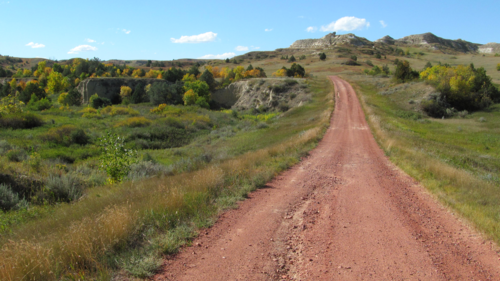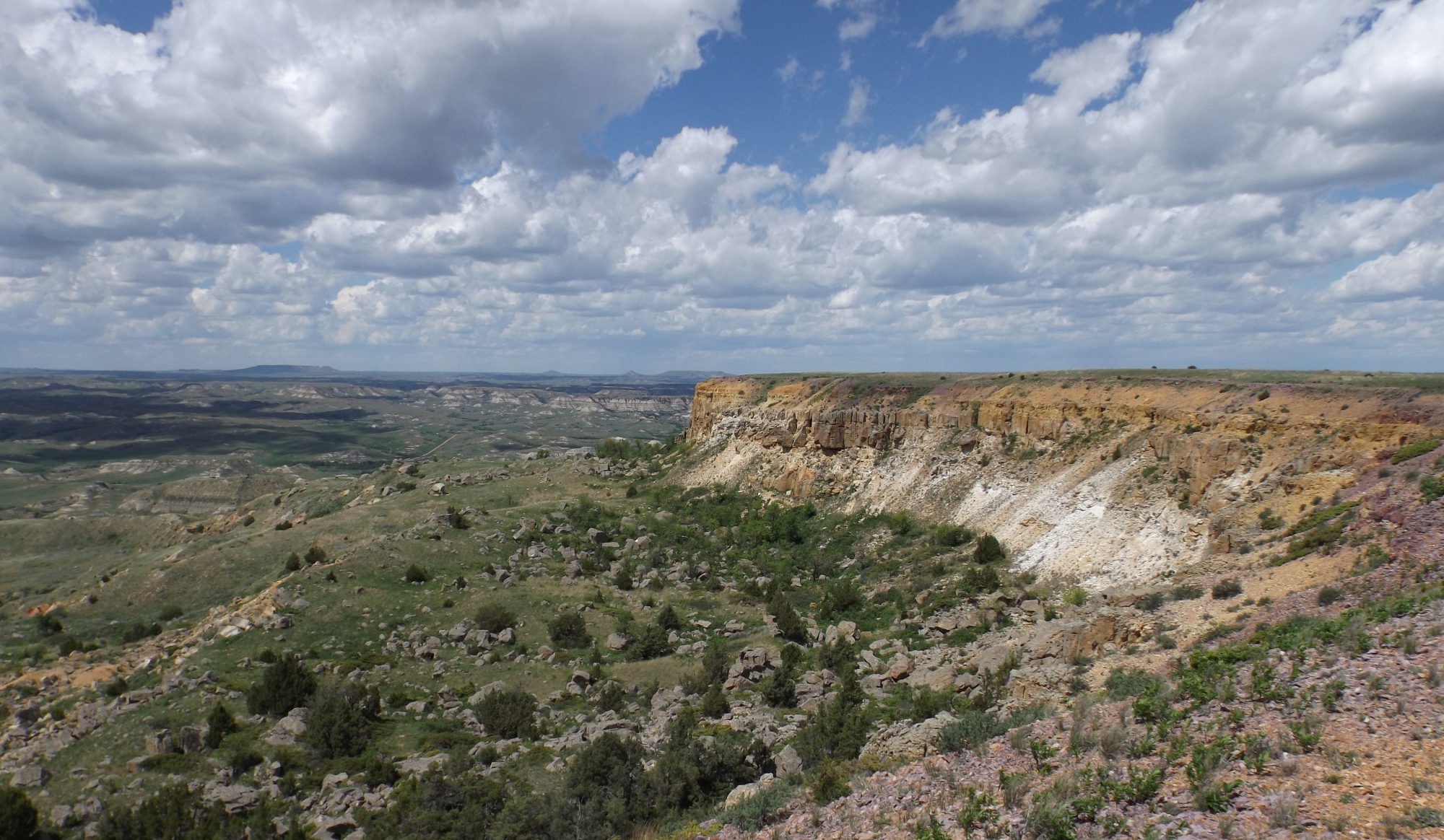In the early 1990s, a group of 17 conservation organizations, as diverse as the National Wildlife Federation, the Bismarck-Mandan Bird Club, the North Dakota Wildlife Society and the Fargo-Moorhead Audubon Society, gathered under a symbolic big tent, and produced a document outlining the dangers facing the North Dakota Bad Lands, and offering a plan to protect some of North Dakota’s most important scenic areas and wildlife habitat.
The document produced by hunters, fishermen, birders, hikers, photographers, canoeists, scientists, teachers and state and federal wildlife officials was titled Bad Lands on the Brink: A North Dakota Wilderness and Wild and Scenic River Proposal.
That 1993 document started with these words:
“In 1964, Congress passed the Wilderness Act ‘to secure for the American people of present and future generations the benefits of an enduring source of wilderness.’ Almost 30 years after passage of the act, the promise is yet to be fulfilled. North Dakota is one of only three states that has not passed a comprehensive statewide U.S. Forest Service wilderness bill.”
South Dakota, with its Black Elk Wilderness Area, designated in 1980 in the Black Hills National Forest, was not one of those three states. They were way ahead of North Dakota.
The document continued:
“The amount of wilderness in North Dakota that qualifies for protection is rapidly diminishing. Five hundred thousand acres of the Little Missouri National Grassland situated in the western North Dakota Bad Lands qualified for wilderness designation in the early 1970s. By 1977, when the second Roadless Area Review and Evaluation (RARE 2) was complete (Note: And when our first oil boom was really getting going), the number of acres eligible for wilderness protection was cut in half. Today (in 1993), only slightly more than 150,000 acres of potential wilderness remains. The major reason for the loss of wild lands has been the development of oil and other resources.

“We, the organizations sponsoring the North Dakota Wilderness Proposal, recognize that oil and gas development contributes greatly to the economic well-being of western North Dakota and is a vital natural resource. But we steadfastly believe that this use must be balanced with other, equally valuable, uses of our public lands.”
And with that introduction, the groups made their case for wilderness in a well-documented 24-page booklet.
Opposition to the conservation groups’ proposal sprang up immediately, spearheaded by the oil industry, which wanted to drill on every available acre of public land, as well as some ranching organizations worried about their grazing rights (even though grazing continues in wilderness areas), and the state’s chamber of commerce. The proposal languished and died a slow death. And development, mostly oil and gas, moved steadily forward into many of the areas designated as “eligible” for wilderness, but still unprotected, in Bad Lands on the Brink.
By 2002, just 9 years later, when the Forest Service finally wrote a new management plan for its million-acre holdings in western North Dakota, the number of acres remaining as “suitable for wilderness” had shrunk from 150,000 to 40,000. The oil industry did its job. If the Forest Service had not written its new plan in 2002, the oil boys might have gotten to all 150,000.

Those 40,000 acres remain today, in 2017, in spite of the Bakken Boom, only because now, 15 years later, the Forest Service has not rewritten that 2002 plan. The Forest Service manages a million acres of National Grasslands in North Dakota, and more than 95 per cent of it is open to oil and gas development. Less than 5 per cent remains “suitable for wilderness.”
And there is still no clear path to official Wilderness designation, with a capital W, for that small part of that vast grassland owned by the people of the United States.
You’re probably asking yourself why this is important. Well, the land we’re talking about is critical habitat for wildlife species such as mule deer, pronghorn antelope, bighorn sheep, and sage and sharptail grouse. It contains some of North Dakota’s most scenic landscapes. When I was a young man, there were nearly half a million acres of western North Dakota free from roads, oil wells, natural gas flares, pipelines and waste disposal and oil storage tank batteries. Because they were free from development, wildlife thrived there. And for me, and thousands of my fellow North Dakotans, this was an outdoor recreation paradise. Now, less than ten per cent of that half million acres remains free from development.
There is another proposal now, though, in the form of the Prairie Legacy Wilderness (click to view it) concept offered by the Badlands Conservation Alliance (BCA), a North Dakota-based conservation and wildlife organization with many members who were part of the original 1993 group. BCA is the voice of the North Dakota wilderness coalition, and it seeks designation of those last 40,000 acres—small islands in the vast sea of the North Dakota grasslands—as official Wilderness.
I wish everyone could read Bad Lands on the Brink, because it really lays out the case for conservation of our wild places, but it’s mostly not possible, because not many copies exist anymore. My wife Lillian and I each saved a copy from our younger days, and we dug them out of old files this winter. The North Dakota State Library and the State Historical Society of North Dakota each have a copy. And I suspect there are a number floating around in the basements or bookshelves of conservation junkies in the Dakotas like Lillian and me. But you can’t buy it or find it in your local library, to my knowledge.
So let me just share a little bit of their writing with you. Remember, this was 1993, and they were still talking about 150,000 acres of undeveloped land.
“These federal lands contain some of the most important wildlife habitat, wilderness and recreational areas found in North Dakota. For instance, the grassland serves as a potential reintroduction site for the endangered black-footed ferret—the rarest mammal in North America. Seven geographically distinct habitats are home to approximately 250 bighorn sheep.
“The area’s topography ranges from deeply incised, dramatically hued canyons to verdant ridges and 200-year-old ponderosa pines. It is this diversity of landscape that offers something for every outdoor enthusiast: scenery for the photographer, challenging terrain for the hiker, and much-sought-after remote opportunities for campers and hunters.
“Yet the enchanting aura of the proposed wilderness is hardly news. Theodore Roosevelt developed much of his conservation ethic during his stay in what is now known as the Little Missouri National Grassland, an ideal that later influenced much of the environmental character of his presidency. Roosevelt, in reflecting on his visit to the area, said: ‘In that land, we led a free and hardy life . . . we knew toil and hardship and hunger and thirst . . . but we felt the beat of hardy life in our veins, and ours was the glory of work and the joy of living.’
“Without wilderness designation for these grasslands, future generations may be robbed of their right to experience life out on the great open spaces, under the magnificent skies of the West. These opportunities are dwindling with each passing year as the pressures for development increase. The American people, through their representatives in Congress, need to set aside wilderness areas within these Western grasslands—before it is too late.”
Well, those words in 1993 were absolutely on target. Today, just four of those tiny islands in the Badlands, and another small spot in the Sheyenne National Grasslands in eastern North Dakota, totaling only 40,000 acres, remain roadless and suitable for Wilderness designation.
Hunters, concerned about the loss of habitat, were active members of both the 1993 coalition and today’s conservation efforts. In the 1993 document, they wrote “It is important to note that while hunting is the most popular recreational activity in most of the proposed wilderness areas—and will continue under wilderness designation—hunters will have to meet new requirements. Motor vehicles will no longer be allowed in wilderness areas. Instead, hunters will be given the opportunity to hunt on foot or on horseback. This is a common mode of hunting in other Western states, but few non-motorized hunting opportunities exist in North Dakota. This proposal presents a unique chance for diversified hunting experiences in the state.”
Meaning, fewer vehicles, or no vehicles, equals more wildlife. It’s the reason elk herds thrive in our national parks, for example. I have friends who are avid mule deer hunters—or were until the Bakken Boom—who hunted exclusively in these roadless areas, both for the love of the unique outdoor experience these areas provided, and the likelihood of filling a tag.
So, efforts by Prairie Legacy Wilderness supporters to designate this last 40,000 acres as Wilderness continue. But we’ve not had a member of our state’s Congressional delegation willing to stand up and introduce the federal legislation necessary, despite the fact that the bill is written and ready to drop into the hopper. If you’d like to help, check out the website www.badlandsconervationalliance.org. You’ll find the proposal there, with detailed maps of the proposed wilderness areas and information on how you can become part of the process.
The Bad Lands, meanwhile remain “on the brink.” We should all remember the words of another U. S. President, Lyndon Johnson, who said, while signing the Wilderness Act of 1964, “If future generations are to remember us with gratitude rather than contempt, we must leave them something more than the miracles of our technology. We must leave them a glimpse of the world as it was in the beginning, not just after we got through with it.”


Hey, dipshit, couldn’t read the article but scanned quickly. I was too disgusted by your misspelling of Badlands throughout. It’s one word. There is no alternate spelling/ wording. You are a disgrace to North Dakota.
LikeLike
That is your comment? Spelling?
LikeLike
The debate has raged for more than a century over the proper spelling of Bad Lands. Theodore Roosevelt used two words, usually both capitalized, in all his writings, and there were a lot of them. So did his first biographer, Herman Hagedorn. His recent biographers just left it that way when they quoted him. More recent usage is mixed, with most using one word, capitalized. I choose TRs usage. These are some really “bad lands to travel through” as the early French explorers wrote.
LikeLike
My brother sent me a text asking if dipshit is one word or two. Checking.
LikeLike
Jim,
Enjoyed this post. However, what I have been struggling with for years is the complete nonchalance about North Dakotas landscape. I drive a 3/4 diesel pickup, I own farmland and deal with farmers regularly. I get the balance between modern day issues and the need to preserve. I am a conservative, a bona-fide, right winger. Yet, even those on the left, the side that might traditionally care in other states about conservation issues, is mostly quiet. I understand there is not a lot of lefties in ND but the loyal opposition to putting a windmill on every hill and a well on every quarter is just not there.
The badlands are past the brink. Way past. North Dakota is just a laboratory for exports and clearly North Dakota residents are just fine with it. The biggest losers are North Dakotas hunters, who don’t seem to care or get that some sort of controlled development needs to take place.
LikeLike